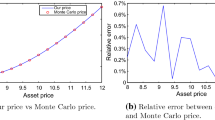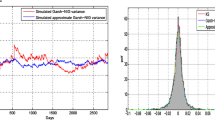Abstract
The contributions of this paper are threefold. The first contribution is the proposed logarithmic HAR (log-HAR) option-pricing model, which is more convenient compared with other option pricing models associated with realized volatility in terms of simpler estimation procedure. The second contribution is the test of the empirical implications of heterogeneous autoregressive model of the realized volatility (HAR)-type models in the S&P 500 index options market with comparison of the non-linear asymmetric GARCH option-pricing model, which is the best model in pricing options among generalized autoregressive conditional heteroskedastic-type models. The third contribution is the empirical analysis based on options traded from July 3, 2007 to December 31, 2008, a period covering a recent financial crisis. Overall, the HAR-type models successfully predict out-of-sample option prices because they are based on realized volatilities, which are closer to the expected volatility in financial markets. However, mixed results exist between the log-HAR and the heterogeneous auto-regressive gamma models in pricing options because the former is better than the latter in times of turmoil, whereas it is worse during the rather stable periods.


Similar content being viewed by others
Notes
More empirical evidence of NGARCH option pricing models are provided as follows. First, in terms of Hang-Seng index options, the empirical performance of NGARCH option pricing model outperforms two ad hoc versions of the BS model (Duan and Zhang 2001). Comparing stochastic volatility model on the FTSE 100 index, Lehar et al. (2002) conclude the empirical results to out-of-sample option pricing performance of FTSE 100 index option show that NGARCH dominates both stochastic volatility and the benchmark BS model.
For example, HARG includes non-linear optimization procedure, while our log-HAR option price model only requires the ordinary-least-square method.
Tick data database sources intraday option data from the Chicago board options exchange (CBOE), and then provides historical tick-by-tick options data for all listed US equity and index options contracts reported by the options price reporting authority (OPRA) back to July 2, 2004. All data is recorded in a timestamp to the second prior to July 1, 2008, and to the millisecond after July 1, 2008.
In Corsi et al. (2010), the authors gather option data from OptionMetrics, and thus ignore the nonsynchroneity problem, which could generate bias empirical analysis in evaluating options.
See, for example, Heston and Nandi (2000).
See Santa-Clara and Yan (2010).
In line with Corsi (2009), for every time of implementing estimation, he selected a data set that contains 1,000 observations in estimating parameters.
To be clear, this paper denotes the square root of the realized variance as realized volatility.
Corsi et al. (2010) study SPX from January 5, 2000 to December 31, 2004.
See “Appendix”.
The word “for” means forecast.
References
Andersen TG, Bollerslev T, Diebold FX, Ebens H (2001a) The distribution of realized return volatility. J Financ Econ 61:43–76
Andersen TG, Bollerslev T, Diebold FX, Labys P (2001b) The distribution of realized exchange rate volatility. J Am Stat Assoc 96:42–55
Andersen TG, Bollerslev T, Diebold FX, Labys P (2003) Modeling and forecasting realized volatility. Econometrica 71:579–625
Andersen TG, Bollerslev T, Diebold FX (2007) Roughing it up: including jump components in the measurement, modeling and forecasting of return volatility. Rev Econ Stat 89:701–720
Baillie R, Bollerslev T, Mikkelsen H (1996) Fractionally integrated generalized autoregressive conditional heteroscedasticity. J Econom 74:3–30
Bakshi G, Cao C, Chen Z (1997) Empirical performance of alternative option pricing models. J Financ 52:2003–2049
Bates DS (1996) Testing option pricing models. In: Maddala GS, Rao CR (eds) Handbook of statistics, statistical methods in finance. Elsevier, Amsterdam, pp 567–611
Battalio R, Schultz P (2006) Options and the bubble. J Financ 61:2071–2102
Bertholon H, Monfort A, Pegoraro F (2008) Econometric asset pricing modelling. J Financ Econom 6:407–408
Black F, Scholes M (1972) The valuation of option contracts and a test of market efficiency. J Financ 27:399–417
Black F, Scholes M (1973) The pricing of options and corporate liabilities. J Polit Econ 81:637–653
Bollerslev T (1986) Generalized autoregressive conditional heteroscedasticity. J Econom 31:307–327
Bollerslev T, Mikkelsen H (1999) Long-term equity anticipation securities and stock market volatility dynamics. Journal of Econom 92:75–99
Christoffersen P, Jacobs K, Ornthanalai C, Wang Y (2008) Option valuation with long-run and short-run volatility components. J Financ Econ 90:272–297
Corsi F (2009) A simple long memory model of realized volatility. J Financ Econom 7:174–196
Corsi F, Fusari N, La Vecchia D (2010). Realizing smiles: options pricing with realized volatility. Swiss Finance Institute research paper no. 10-05. Available at SSRN: http://ssrn.com/abstract=1547032
Ding Z, Granger C, Engle R (1993) A long memory property of stock market returns and a new model. J Empir Financ 1:83–106
Duan JC (1995) The GARCH option pricing model. Math Financ 5:13–32
Duan JC, Zhang H (2001) Hang Seng index options around the Asian financial crisis: a GARCH approach. J Bank Financ 25:1989–2014
Dumas B, Fleming J, Whaley R (1998) Implied volatility functions: empirical tests. J Financ 53:2059–2106
Eisenberg L, Jarrow R (1994) Option pricing with random volatilities in complete markets. Rev Quant Financ Acc 4:5–17
Feunou B, Meddahi N (2009). Generalized affine models. Available at SSRN: http://ssrn.com/abstract=1367033
Gourieroux C, Jasiak J (2006) Autoregressive gamma process. J Forecas 25:129–152
Gultekin B, Rogalski R, Tinic S (1982) Option pricing model estimates: some empirical results. Financ Manag 11:58–69
Heston S, Nandi S (2000) A closed-form GARCH option valuation model. Rev Financ Stud 13:585–625
Hsieh K, Ritchken P (2005) An empirical comparison of GARCH option pricing models. Rev Deriv Res 8:129–150
Lee CF, Wu T-P, Chen R–R (2004) The constant elasticity of variance models: new evidence from S&P 500 Index options. Rev Pac Basin Financ Mark Policies 7:173–190
Lee CF, Tzeng G-H, Wang S-Y (2005) A fuzzy set approach for generalized CRR model: an empirical analysis of S&P 500 index options. Rev Quant Financ Acc 25:255–275
Lehar A, Scheicher M, Schittenkopf C (2002) GARCH versus stochastic volatility: option pricing and risk management. J Bank Financ 26:323–345
Santa-Clara P, Yan S (2010) Crashes, volatility, and the equity premium. Rev Econ Stat 92:435–451
Stentoft L (2008) Option pricing using realized volatility. Working paper at CREATES, University of Copenhagen
Whaley R (1982) Valuation of American call options on dividend-paying stocks. J Financ Econ 10:29–58
Yuan HM, Zhang H (2003) An empirical investigation of the GARCH option pricing model: hedging performance. J Futur Mark 23:1191–1207
Zhang L, Ait-Sahalia Y, Mykland PA (2005) A tale of two times scales: determining integrated volatility with noisy high frequency data. J Am Stat Assoc 100:1394–1411
Author information
Authors and Affiliations
Corresponding author
Additional information
This paper has been accepted for presentation at the 3rd international conference on business in Asia (iCBA) and the 17th annual conference on Pacific Basin finance, economics, accounting and management (PBFEAM) which will be held on July 1–2, 2009.
Appendix
Appendix
Assuming r t = 0 (for computational convenience), the SDF satisfies the following framework:
It complies with the no arbitrage conditions if the following implicit parameter-restrictions are satisfied:
where \( \nu_{1} \) remains a free parameter.
Rights and permissions
About this article
Cite this article
Jou, YJ., Wang, CW. & Chiu, WC. Is the realized volatility good for option pricing during the recent financial crisis?. Rev Quant Finan Acc 40, 171–188 (2013). https://doi.org/10.1007/s11156-012-0285-0
Published:
Issue Date:
DOI: https://doi.org/10.1007/s11156-012-0285-0




